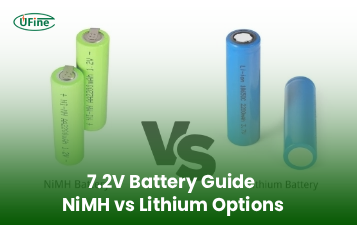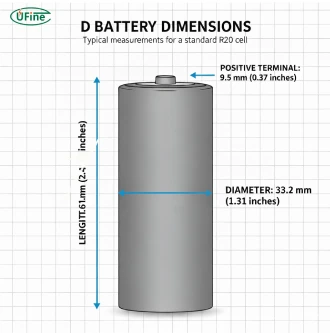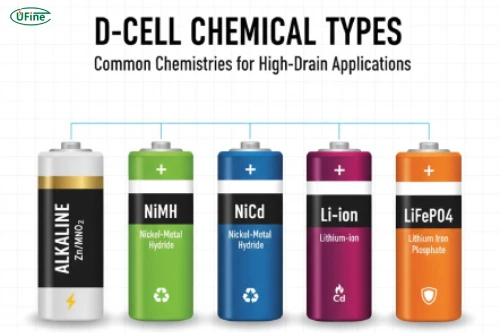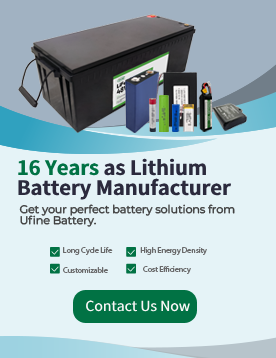
- Part 1. What size is a D battery?
- Part 2. What voltage are D batteries?
- Part 3. How much does a D battery weigh?
- Part 4. Average lifespan of rechargeable D-cells
- Part 5. Capacity and runtime: How long does a single charge last?
- Part 6. Rechargeable D batteries vs. non-rechargeable D batteries
- Part 7. Factors that affect rechargeable D-cell lifespan
- Part 8. How to charge rechargeable D-cells properly
- Part 9. Maintenance and storage tips to extend life
- Part 10. Signs your rechargeable D-Cell needs replacement
- Part 11. D-Cells in action: where they excel
- Part 12. FAQs
Part 1. What size is a D battery?
A D-cell battery has a standardized size to fit universally in compatible devices:
- Diameter: 33.2 ± 0.1 mm (1.3 inches)
- Length: 61.5 ± 0.1 mm (2.4 inches)
- Shape: Cylindrical, with a positive terminal nub and flat negative base
Despite being standardized, rechargeable D-cells (especially lithium-based ones) may have slight size variations due to protective circuitry or casing differences. Always check device fit before purchasing replacements.
Part 2. What voltage are D batteries?
Voltage depends on the battery’s chemistry:
| Battery Type | Nominal Voltage (V) | Rechargeable |
|---|---|---|
| Alkaline D-cell | 1.5V | No |
| NiMH D-cell | 1.2V | Yes |
| NiCd D-cell | 1.2V | Yes |
| Li-ion D-cell | 3.6V–3.7V | Yes |
| LiFePO4 D-cell | 3.2V | Yes |
Most rechargeable D-cells operate at 1.2V, similar to NiMH or NiCd chemistries, while lithium-based rechargeable D-cells offer higher voltages suitable for modern electronics.
Part 3. How much does a D battery weigh?
The weight of a D battery varies based on chemistry and construction:
- Alkaline D-cell: ~135–150 g
- NiMH D-cell: ~160–180 g
- NiCd D-cell: ~170–200 g
- Li-ion D-cell: ~90–100 g
- LiFePO4 D-cell: ~110–120 g
Rechargeable D-cells, especially NiMH and NiCd, tend to be heavier due to thicker electrode materials and denser internal structures designed for durability.
Part 4. Average lifespan of rechargeable D-cells
The lifespan of a rechargeable D-cell depends on its chemistry, charging habits, and usage environment. Here’s a quick comparison:
| Chemistry | Cycle Life (Typical) | Notes |
|---|---|---|
| NiMH D-cell | 500–1,000 cycles | Reliable and stable for everyday use |
| NiCd D-cell | 300–500 cycles | Strong under heavy loads, but less eco-friendly |
| Li-ion D-cell | 800–2,000 cycles | High capacity, lighter weight |
| LiFePO4 D-cell | 2,000–3,000+ cycles | Longest lifespan, high safety margin |
Each “cycle” refers to one full charge and discharge. In real-world use, shallow discharges (using only part of the capacity before recharging) can significantly extend total cycle life.
What is the Lithium Battery Charging Cycle?
If you charge and discharge a NiMH rechargeable D-cell once a week, it can last 8–10 years under ideal conditions.
Part 5. Capacity and runtime: How long does a single charge last?
A D-cell’s runtime depends primarily on its capacity, measured in milliamp-hours (mAh), and the current draw of your device.
Typical rechargeable D-cell capacities:
- NiMH: 8,000–12,000 mAh
- NiCd: 3,000–5,000 mAh
- Li-ion: 10,000–14,000 mAh
- LiFePO4: 6,000–10,000 mAh
To estimate runtime:
Runtime (hours) = Battery Capacity (mAh) ÷ Device Current Draw (mA)
For example, a 10,000mAh D-cell powering a 500mA flashlight could last roughly 20 hours per charge.
NiMH rechargeable D-cells are particularly well-suited for steady, high-drain devices, maintaining a stable voltage until almost depleted.
Part 6. Rechargeable D batteries vs. non-rechargeable D batteries
The main difference between rechargeable and non-rechargeable D-cells lies in chemistry, reusability, and long-term cost.
| Feature | Rechargeable D-cell | Non-Rechargeable D-cell (Alkaline) |
|---|---|---|
| Chemistry | NiMH, NiCd, Li-ion, LiFePO4 | Alkaline or Zinc-carbon |
| Recharge Cycles | 500–3,000+ | Single use |
| Voltage | 1.2V to 3.7V | 1.5V |
| Cost per Unit | Higher upfront | Lower upfront |
| Long-Term Value | Excellent | Poor |
| Environmental Impact | Reusable, recyclable | Waste-generating |
While disposable D batteries are convenient for occasional use, rechargeable D-cells are far more economical and sustainable in the long run.
Part 7. Factors that affect rechargeable D-cell lifespan
Even the best D-cell batteries degrade over time. The key to longevity lies in how you use and maintain them.
1 Charging Habits
Overcharging or using incompatible chargers is one of the main causes of premature battery wear. Use smart chargers that automatically detect full charge and cut off current to prevent overheating.
2 Temperature
High temperatures accelerate chemical breakdown inside the cell, while extremely cold conditions reduce charge acceptance. Store and use rechargeable D-cells between 0°C and 40°C (32°F–104°F) for best results.
3 Depth of Discharge
Avoid draining the battery completely each time. Partial discharges (e.g., recharging when capacity drops to 30–40%) reduce stress and extend total cycle life.
4 Storage Conditions
If not used for months, store batteries at 40–60% charge in a cool, dry place. This helps prevent capacity loss and self-discharge.
Part 8. How to charge rechargeable D-cells properly
Proper charging is crucial to maximizing battery life and safety.
- Use a dedicated D-cell charger. Chargers designed for smaller batteries may overheat or undercharge D-cells due to their higher capacity.
- Charge at moderate currents. A charge rate between 0.1C and 0.5C (where C = capacity in Ah) is ideal. For a 10,000mAh battery, that’s 1,000–5,000mA.
- Avoid continuous trickle charging. Keeping the battery connected after full charge generates heat and shortens its life.
- Choose smart chargers. Models with delta-V detection or temperature monitoring help avoid overcharging.
Ufine Battery recommends using chargers with voltage cutoff and temperature sensors, especially for industrial or continuous-use applications.
Part 9. Maintenance and storage tips to extend life
Rechargeable D-cells are durable, but regular care can significantly extend their life:
- Charge before storage: Keep them at about 50% charge if not used for several months.
- Cycle occasionally: Discharge and recharge every 3–6 months to maintain chemical balance.
- Clean terminals: Dirty contacts increase resistance and heat; wipe with a dry cloth before use.
- Avoid moisture and direct sunlight: These accelerate corrosion and degrade seals.
With proper maintenance, a good NiMH rechargeable D-cell can provide years of dependable service for flashlights, medical devices, or industrial tools.
Part 10. Signs your rechargeable D-Cell needs replacement
Even the most reliable battery won’t last forever. Common signs that your rechargeable D-cell is reaching the end of its life include:
- Noticeably shorter runtime despite full charge
- Longer charging time than usual
- Overheating during charge or discharge
- Physical swelling or leakage
- Device performance drops or intermittent power loss
Part 11. D-Cells in action: where they excel
Rechargeable D-cells remain popular for high-capacity and high-drain applications such as:
- Heavy-duty flashlights and lanterns
- Portable radios and emergency sirens
- Medical or industrial equipment
- RC models and robotics
Their combination of large capacity, long runtime, and stable voltage makes them reliable for both home and professional use.
Part 12. FAQs
Can I use rechargeable D-cells in any device that takes regular D batteries?
In most cases, yes — rechargeable D-cells are designed to match the same size and fit as standard D batteries. However, note that NiMH and NiCd D-cells have a nominal voltage of 1.2V, slightly lower than the 1.5V of alkaline cells. Some older devices may not perform optimally if they rely on the higher voltage, so check your device’s specifications first.
How long does it take to fully charge a rechargeable D-cell?
Charging time depends on the battery’s capacity (mAh) and the charger’s current (mA). For example, a 10,000mAh NiMH D-cell charged at 1,000mA (1A) takes roughly 10–12 hours. Using a higher-current smart charger can reduce charge time safely, but avoid exceeding manufacturer-recommended rates to prevent overheating or reduced lifespan.
Why do some “rechargeable D batteries” feel lighter than others?
That’s a great observation — some low-cost “rechargeable D batteries” are actually sub-C or AA cells encased in D-sized shells, providing much lower capacity than true full-size D-cells. Always check the rated capacity (mAh) and buy from reputable brands such as Ufine Battery, which manufactures genuine high-capacity rechargeable D-cells built with full-sized cells.
Can I mix rechargeable D-cells with non-rechargeable ones in the same device?
No — mixing battery types can cause voltage imbalance, leakage, or even short-circuiting. Rechargeable and non-rechargeable batteries discharge at different rates and voltages. Always use identical batteries (same brand, chemistry, and charge level) together for optimal safety and performance.
Do rechargeable D-cells lose charge when not in use?
Yes, all rechargeable batteries experience self-discharge, but the rate varies by chemistry. NiMH D-cells typically lose 15–30% of their charge per month, while Li-ion and LiFePO4 D-cells retain most of their capacity for several months. To minimize loss, store batteries in a cool, dry place and top them up every few months if unused.
Related Tags:
More Articles

NiMH vs Lithium 7.2V Battery and Charger: Which Is Better?
Compare 7.2V NiMH vs Lithium batteries and chargers in 2025. Learn runtime, weight, charging, lifespan, and cost to choose the best for your device.
How to Choose the Right 7.2V Battery and Charger for Your Device?
Learn how to choose the right 7.2V battery and charger for optimal performance, safety, and longevity across RC, tools, medical, and industrial devices.
Big Square Battery Safety Standards You Must Know
Learn key safety standards for big square batteries to avoid fire risks, shipping delays, and compliance issues in EV, industrial, and energy storage projects.
Big Square Battery Applications in Solar & Industrial Equipment
Big square batteries deliver high capacity, stable output, and long life for solar, industrial, and backup power. Explore key uses and advantages.
Big Square Battery vs Cylindrical Battery: Complete 2025 Guide for EVs, ESS & Industrial Devices
Choosing the right battery is key for designers and engineers. Compare big square vs cylindrical batteries to find the best fit for your application.




